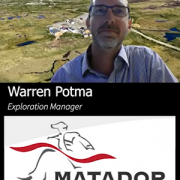Matador Mining Ahead of Aussie Canadian Pack
THE CONFERENCE CALLER: Canada-focused gold explorer Matador Mining (ASX: MZZ) may well have found itself at the forefront of Australian juniors when it comes to using a much-lauded tax-based exploration funding mechanism which has received very little political sympathy Down Under. By Mark Fraser
During the middle of 2020, the West Australia-based company – which is well on the way to developing its emerging Cape Ray gold project in Newfoundland – raised $8.7 million through a share placement, adding a 40% premium to its stock via the Canadian charity flow-through shares scheme.
Not only did this help Matador fund its planned 2021 Canadian field program, it also saw the junior become one of the first ASX-listed outfits to complete such a placement – in effect making it a leader of an industry tax reform movement which hasn’t received much publicity lately, but has remained in the background since the case for this investor-friendly tax mechanism was unsuccessfully made to consecutive Coalition and Labor federal governments during the first decade of the 2000s.
No doubt the company will be successful in highlighting the effectiveness of this incentive to the appropriate authorities, judging from the results it’s achieving while turning Cape Ray into a viable investment concern.
Matador controls 425 square kilometres of exploration tenements in Newfoundland’s lightly explored, but highly prospective, Cape Ray Shear Zone, a geological structure which runs about 400km through the island province.
The company is the largest ground holder along this shear (about 120km of continuous strike) and its tenement boundary sits around 50km along strike from Marathon Gold’s (TSX: MOZ) 4.2-million-ounce Valentine Lake gold project.
When completed Valentine will be the largest gold mine in Atlantic Canada and a major contributor to the Newfoundland and Labrador economies.
As of last October, Cape Ray had a total mineral resource of 12.9 million tonnes at 2.02 grams per tonne for 873,000 gold ounces.
This, however, didn’t take into account the new Angus discovery, about 1km south west of the already existing Window Glass Hill ore body, where five of the first eight holes intersected multiple intervals of yellow metal including 12 metres at 8.3g/t from 85m, 35m at 0.52g/t from 34m and 10m at 0.67g/t from 15m.
Towards the end of 2020, Matador released further drill results that caught the market’s eye sourced from three target areas – Window Glass Hill, the Isle Aux Morts and Angus.
Resource infill and extension drilling at Window Glass Hill returned gold assays of 15m at 1.01g/t from 34m and 6.7m at 1.51g/t (within 13m at 0.87g/t) from 116m, as well as 0.34m at 12.31g/t from 151.4m.
Meanwhile, at the Isle Aux Morts, some of the better mineral resource infill drilling numbers were 20m at 5.08g/t from 8m (including 1.67m at 35 g/t), 11m at 2.51g/t from 7m (including 6m at 4.12g/t), 12m at 1.02g/t from 45m (including 2.47m at 3.84g/t), 1.47m at 1.7g/t from 72m and 1m at 1.96g/t from 79m.
As for Angus, the intersections kept coming, including 7m at 2.02g/t (within 30m at 0.74g/t) from 19m, 3m at 0.67g/t from 67m as well as 1m at 2.66g/t from 92m in one hole, followed by 7m at 1.27 g/t (within 11m at 0.9g/t) from 98m, 7m at 1.12g/t from 116m and 21m at 0.34g/t from 71m in another.
This was followed by 3m at 1.95g/t from 48m (including 0.3m at 17.73g/t).
Matador’s stage-gated “drill and assess” approach to Angus was implemented to allow detailed structural analysis and modelling of the early drill results in order to optimise the follow-up drilling of this new target area.
Cape Ray executive chairman Ian Murray said the resource expansion and greenfields exploration drilling continued to deliver shallow multi-gram per metre gold intersections.
“Approximately 75 per cent of the 2020 drill program was focused on newly identified greenfield targets and resource expansion step-out drilling,” he explained.
“Results to date reinforce our thesis that we are in a sizeable, but poorly explored, gold system as we focus on materially growing our current mineral resource.
“Whilst drilling has successfully concluded for the year, we still have 31 holes/4,325m of drilling pending assay results, which we anticipate will be announced during the March 2021 quarter.”
Matador’s corporate strategy is to increase its resource base to a size that will support a 10-year operation.
This will come from a combination of expanding the resource at existing discoveries and drilling greenfields targets.
The company is undertaking a target generation program at the project, to systemically test a number of previously underexplored priority areas where there appears good potential for gold mineralisation.
Email: info@matadormining.com.au





